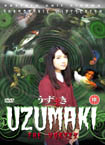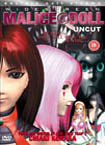| Release List | Reviews | Price Search | Shop | Newsletter | Forum | DVD Giveaways | Blu-Ray/ HD DVD | Advertise |
| Reviews & Columns |
|
Reviews DVD TV on DVD Blu-ray International DVDs Theatrical Reviews by Studio Video Games Features Collector Series DVDs Easter Egg Database Interviews DVD Talk TV DVD Talk Radio Feature Articles Columns Anime Talk DVD Savant HD Talk Horror DVDs Silent DVD
|
DVD Talk Forum |
|
|
| Resources |
|
DVD Price Search Customer Service #'s RCE Info Links |
|
Columns
|
 |
Savant Pal Region 2 Guest Review:
Uzumaki
|

|
Uzumaki Eastern Cult Cinema 2000 / Colour and B&W / 1.77 anamorphic 16:9 / 92 m. Starring Eriko Hatsune, Fhi Fan, Keiko Takahashi, Ren Osugi, Taro Suwa, Hinako Saeki, Masami Horiuchi, Sadao Abe Cinematography Gen Kobayashi Production Designer Hiroshi Hayashida Original Music Tetsuro Kashibuchi & Keiichi Suzuki Written by Junji Ito Produced by Sumiji Miyake Directed by Higuchinsky |
The nearest point of reference for this bizarre and macabre offering has to be the Twin Peaks TV series and David Lynch's work in general. Strange things are happening in the initially normal-seeming town of Kurouzucho but most of the weird locals, who are brought to life via some intentionally campy and kitschy acting and characterisation, are too wrapped up in their own eccentricities to notice: the kids' teacher is a twitchy bag of nerves, the local cop's biggest concern is trying to stop Shuichi and Kirie from sharing the same bicycle, would-be bad girl Kyoko Sekino (Hinako Saeki) wants to be noticed whatever the cost, the creepy Mitsuru Yamaguchi (Sadao Abe) continually concerns himself with trying to make Kirie jump and an insanely intense greengrocer supplies melons that are capable of provoking the kind of enthusiastically appreciative conversations that a slice of cherry pie or a good cup of coffee might prompt in Twin Peaks.
The animatedly ditzy Kirie and the smart but slightly nerdy Shuichi aren't really that committed to solving the mystery of the spiral invasion. Having witnessed the spirals' destructive potential and their ability to possess human hosts, the pair would be much happier if they could just leave town. Tamura, the reporter, is a bit more persistent but even he can't turn up much more than vague theories about a mysterious ancient cult connected to nearby Dragonfly Pond. The strange occurrences just keep on happening but (spoiler begins....) the kids realise that the game is as good as up when they find the normally reliable Mr Goshima (Taro Suwa) distractedly mumbling about a bucketful of clay from Dragonfly Pond that he intends spinning spirally on his potter's wheel: by this time, two of their fellow pupils have metamorphosed into giant snails and Kyoko Sekino is prowling the school's corridors sporting ceiling-fondling, spiral-shaped hair (....spoiler ends).
This Manga comic strip brought to celluloid life is a fairly unique if unsettling production: much of the storyline is propelled by a series of thoroughly morbid and downright disturbing scenarios and suggestions. And Higuchinsky has a Lynch-like propensity for regularly punctuating the narrative with some really shocking moments that are particularly unpleasant and overly detailed. But it's all held together by some noticeably good and consistently stylish cinematography. The whole show bears a kind of light green tint which enhances the many shades of red, brown and dark green that have been incorporated into the film's costumes and set design (a little like sections of Jean-Pierre Jeunet's Amelie). Higuchinsky also utilises strange Lynch-like background noises and eerie synth sounds which he allows to build in intensity during moments of tension and suspense.
But, in the end, Uzumaki is slightly let down by the fact that it largely feels like just one episode of an unfinished series. There is no satisfactory conclusion. Several subplots and possible explanations are hinted at but they are never fully developed or returned to, even though they seem to hold potential significance. (....Spoiler begins) The film's final chapter is a montage of still shots which hurriedly reveal what became of most of the film's main characters but ultimately offer no real explanation as to what actually happened to them. And it is never explained where Kirie, who appears to be telling the story via a flashback, is and how she got there (....spoiler ends). But such criticism does not alter the overall impression that this disquietingly dark and creepy film has the words 'cult movie' written all over it.
The picture quality here is pretty much excellent. There's hardly a scratch or a speckle to be had and the image is sharp. The disc's overall sound quality is excellent too, with the film being presented in Japanese with optional English subtitles. The Uzumaki Q featurette flips between behind the scenes footage and a somewhat bizarre interview with Eriko Hatsune.

|
Malice@Doll Eastern Cult Cinema 2000 / Colour / 4:3 & 1.77:1 anamorphic / 74 m. Starring Yukie Yamada (voice of Malice) Production Designers Shinobu Nishioka, Yasu Moriki Written by Chiaki Konaka Directed by Keitaro Motonaga |
While the bulk of the animation employed here is CGI-based, the makers of Malice@Doll have chosen to reject the idea that CGI should be used to recreate 'reality' in the way that features like Final Fantasy do. While the Dolls' bodies are represented quite realistically, their faces conform to the familiar generic shapes associated with Japanese Anime. And some of the animation here boasts a distinctive 'jerkiness' (an attempt to recreate the look of Czechoslovakian stop-motion puppet animation) while most of the camera work is of a static nature: an interesting contrast to the fluid animation and acrobatic camera moves normally associated with CGI productions. The general look of this show is very dark and gloomy and much of the set design is purposefully strange and surreal. The maintenance and administration droids are an unconventionally constructed bunch but the creatures that they, and some of the Dolls, eventually transform into are even more bizarre.
It's hinted (I think) that Malice's dream of escaping a humdrum and repetitive existence was somehow powerful enough to set the strange events that unfold in motion but Malice is eventually admonished by Joe Admin for mistakenly thinking that all of the other robots felt the same way as her. As it is, the other Dolls remain governed by habit (or their old programming) and they immediately seek to discover how their new bodies will enhance their particular take on sexual engagement: something the newly transformed maintenance droids are happy to respond to. But when Malice contrasts her friends' present position with memories from her time as a pleasure Doll it seems that the Dolls' physical and emotional transformations haven't really served to liberate them that much. Some of the sex scenes presented here almost border on the explicit, so much so that Malice@Doll is reportedly the first CGI feature to be saddled with an 18 certificate in the UK.
The surreal quality of Malice@Doll's design extends to and envelopes its narrative: it's not at all straightforward and, in parts, it's less than coherent. The vision that Malice beholds (a Victorian girl holding a glowing orb?), the strange room that she is drawn to (a deserted, The Prisoner-like control/observation room that has a weird 'two-faced' sculpture at its centre) and the tentacled creature that subsequently attacks her have a huge impact on the story but their origins, intentions or real significance are never explained. (....Spoiler begins) When things eventually turn sour, Malice seems (I think) to be able to will herself the chance to somehow step back in time and force an alternative denouement: Joe Admin's confrontation with a rogue security robot seems to conclude differently, the other robots appear to be restored in some capacity and Malice appears to be reborn in spirit form (....spoiler ends).
Interestingly, the film's final chapter automatically links straight back to the start of chapter one - which opens with Malice shut-down and dreaming - so maybe the whole thing is simply a robot's cyclic dream? But didn't Joe Admin say that robots can't dream? This film undoubtedly possesses some interesting qualities, and some sequences are genuinely engaging and thought provoking, but the periodic appearance of confusing plot lines or baffling lapses in continuity are frustrating. Konaka has provided scripts for popular mainstream TV titles like Ultraman and Digimon: Digital Monsters so it can only be assumed that he has been wilfully opaque in his scripting of Malice@Doll.
Malice@Doll's picture is free from scratches and suchlike but it is a little grainy in parts. The sound is pretty much excellent, with the feature being presented in Japanese with optional English subtitles. The 16:9 version has been created by cropping and anamorphically enhancing the original 4:3 presentation. The disc's interview section has Yukie Yamada (the voice of Malice) discussing the show with its writer and director.
Both discs are PAL Region 2, and are not intended for playback in the U.S.
On a scale of Excellent, Good, Fair, and Poor,
Uzumaki rates:
Movie: Very Good -
Video: Excellent
Sound: Excellent
Supplements: Uzumaki Q featurette, trailer, promotional artwork, stills
gallery and biographies & filmographies.
Packaging: Keep case
Reviewed: April 4, 2003
On a scale of Excellent, Good, Fair, and Poor,
Malice@Doll rates:
Movie: Fair ++ / Good -
Video: Very Good +
Sound: Excellent
Supplements: Yukie Yamada interviews Keitaro Motonaga & Chiaki Konaka, trailer,
director's biography & filmography and crew filmographies.
Packaging: Keep case
Reviewed: April 4, 2003
Review Staff | About DVD Talk | Newsletter Subscribe | Join DVD Talk Forum
Copyright © MH Sub I, LLC dba Internet Brands. | Privacy Policy | Terms of Use
|
| Release List | Reviews | Price Search | Shop | SUBSCRIBE | Forum | DVD Giveaways | Blu-Ray/ HD DVD | Advertise |





